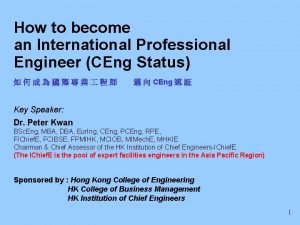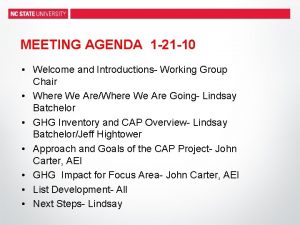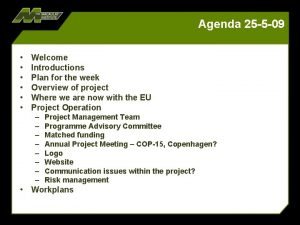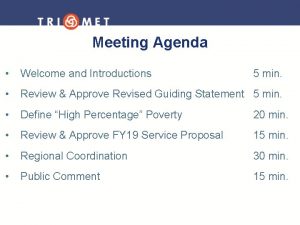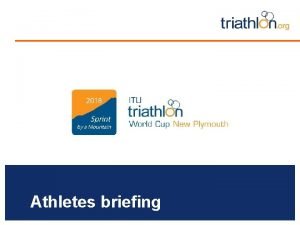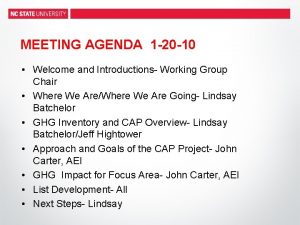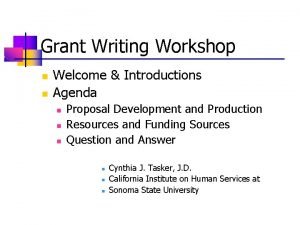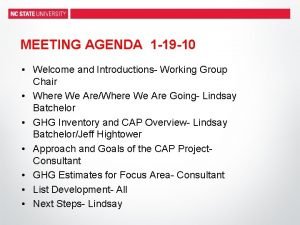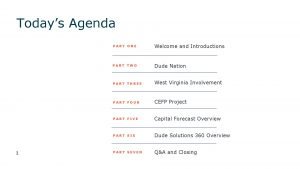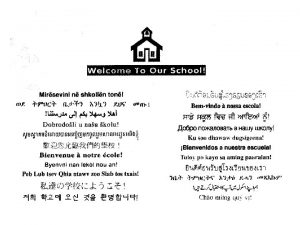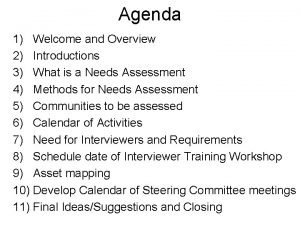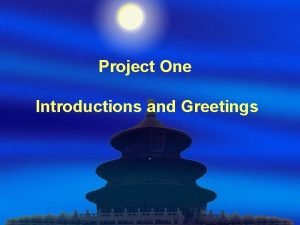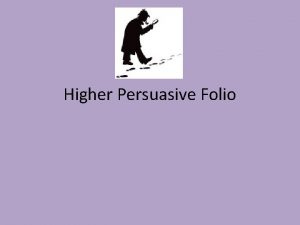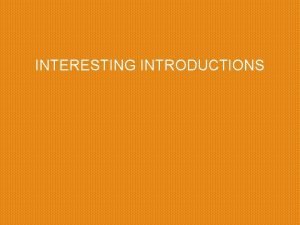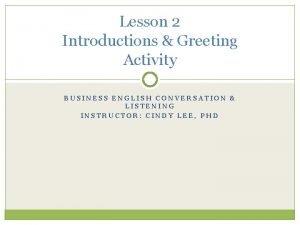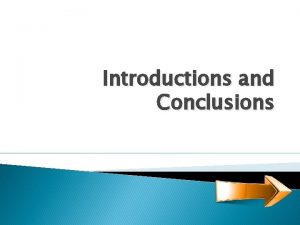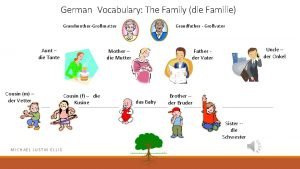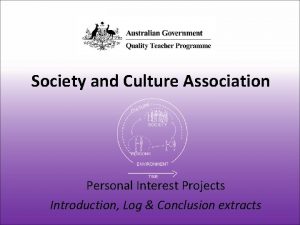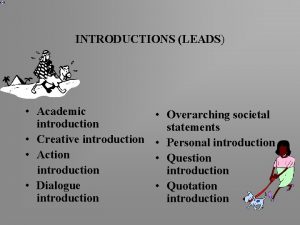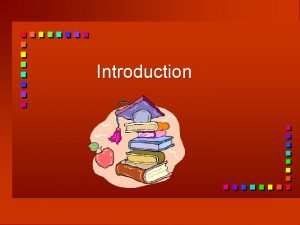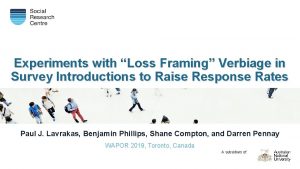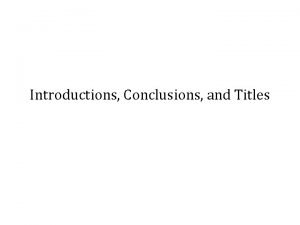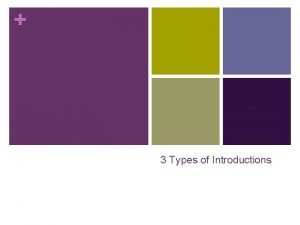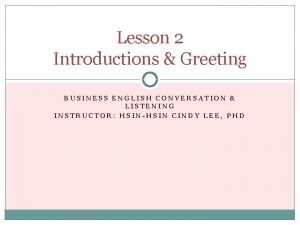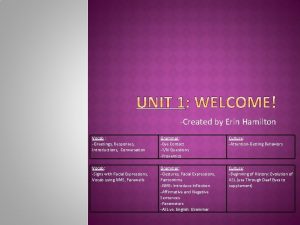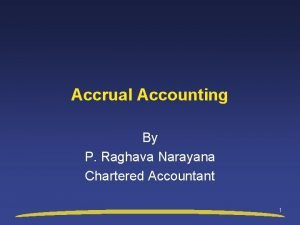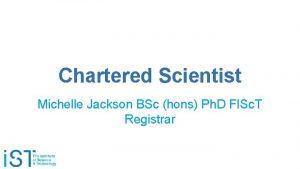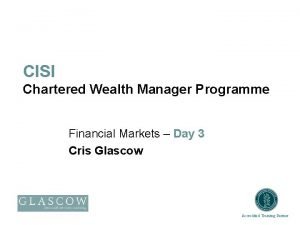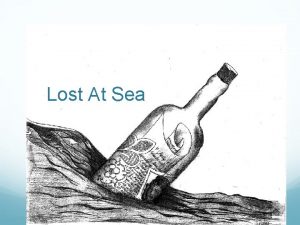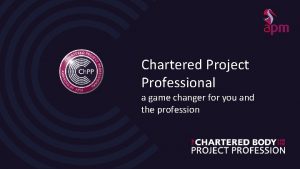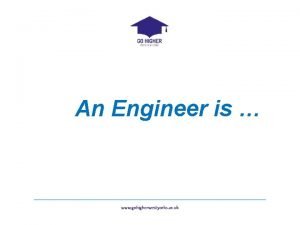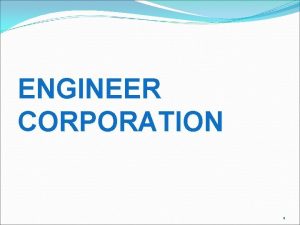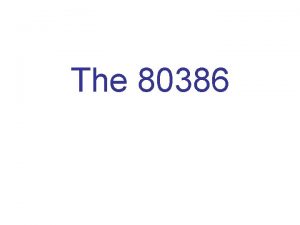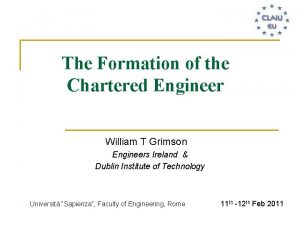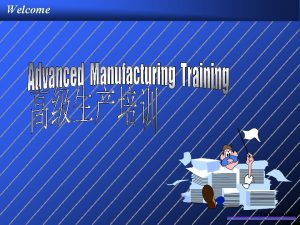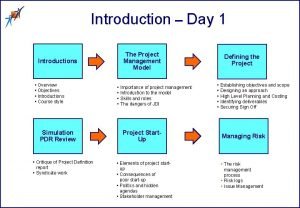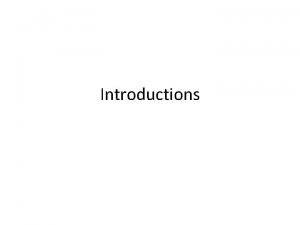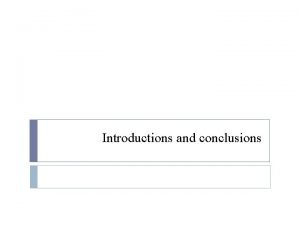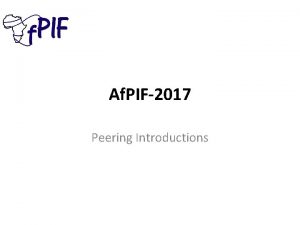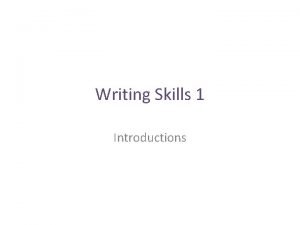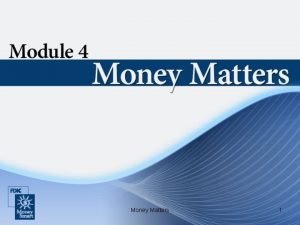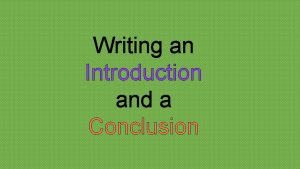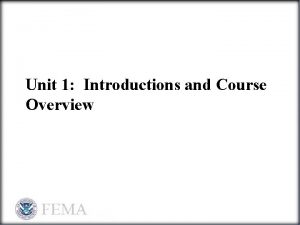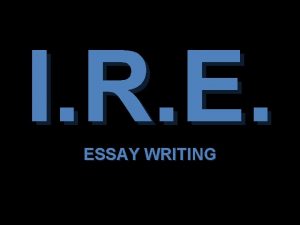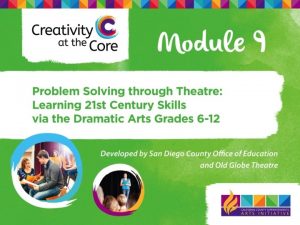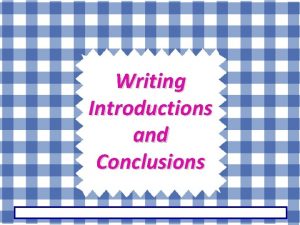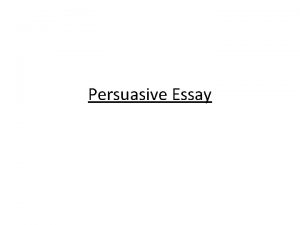The Chartered Engineer The Chartered Engineer Welcome Introductions










































- Slides: 42

The Chartered Engineer

The Chartered Engineer • Welcome • Introductions • Personal thoughts • How to go from A to B

CEng MIStruct. E • Global standard of excellence • 105 countries • Ireland, UK, Australia, NZ, Canada, Middle East etc.

Why CEng MIStruct. E? • Rigorous standard • IPD – portfolio of experience, core objectives • Formal examination

Purpose of tonight’s lecture? • Clearly explain the process • Give you contacts to support you through the process • Demystify the process

A daunting process? • Applicants overly focussed on the exam and the low pass rate • Experience • Preparation

Experience • IStruct. E recommends 4 to 5 years relevant experience (IPD Phase) • Exam – one week in the design office squeezed into 7 hours • Development of two distinct solutions • Draw on a range of skills and knowledge including geotechnical engineering

Experience

Preparation • Lack of preparation • Finding time in a busy professional life • Finding time in your personal life

Preparation (~ 6 months) • Preparing a lever arch folder • Undertaking random papers - no time limit • Time limit of a weekend • Trial runs within time limit

Route to Membership

Route to Membership – MRA (Mutual Recognition Agreement) CEng MIEI

IPD

IPD

PRI – Professional Review Interview

PRI – Professional Review Interview

Chartered members of the Institution will be able to demonstrate: • A sound understanding of core structural engineering principles. • The ability to use relevant existing technology coupled with the ability to locate and use new research and development to benefit their work and structural engineering generally. • The ability to solve complex structural engineering problems and produce viable structural design solutions using appropriate methods of analysis. • The ability to exercise independent judgement in the application of structural engineering science and knowledge. • Technical, management and leadership skills to plan, manage and direct human, material and financial resources.

• Commitment to the public interest in all aspects of their work, including health, safety, risk, financial, commercial, legal, environmental, social, energy conservation and sustainability. • Effective communication and interpersonal skills. • Knowledge of the statutory and other regulations affecting current practice in structural engineering. • A significant base of information technology skills. • Commitment to the profession of structural engineering, particularly with regard to the Institution’s Code of Conduct and the requirement for Continuing Professional Development.

There are three stages in becoming a Chartered member of the Institution: 1. Achievement of the required educational base. 2. A period of responsible work experience initially under guidance and supervision, known as Initial Professional Development (IPD). 3. Success in the Institution Professional Review (PR) which normally includes the Professional Review Interview and Chartered Membership Examination

The core objectives of your training are arranged in three sections: 1. Personal: effective communication and interpersonal skills, leadership and professional commitment. 2. Engineering: identification and solution of engineering problems and the safe, economic and sustainable implementation of the solutions. 3. Management and commercial: efficient procurement and management of resources within economic, environmental and regulatory constraints to achieve the engineering objectives

The minimum standards required for the core objectives are: A Appreciation A general appreciation of the subject is required, as well as an understanding of how the subject may affect, or integrate, with other subjects. K Knowledge A knowledge and understanding of the subject and its application is required. E Experience The subject should be performed independently or under supervision. B Ability Perform the subject without supervision and be competent to advise others.

The Core Objectives

1. 0 PERSONAL 1. 1 INSTITUTION Objective: Knowledge of the Institution and involvement in Institution affairs The candidate should demonstrate knowledge of the structure and purpose of the Institution of Structural Engineers, together with an awareness of the Institution’s Code of Conduct.

• Regular attendance at regional group meetings/seminars over a prolonged period of time • Regular contact with members of the regional group committee • Knowledge of and adherence to the Institution’s Code of Conduct • Knowledge of the Institution’s Council and committee structure and the work of those committees • Regular use of the Institution’s website • Regular review of the Structural Engineer journal • Knowledge of the Institution services including CPD courses and the library • Knowledge of the international dimension of the Institution • Knowledge of other institutions and disciplines • Industrial engagement with a local university/college in terms of delivering lectures, assisting in the marking of project work and mentoring

1. 2 COMMUNICATION Objective: Ability to demonstrate effective communication and interpersonal skills The candidates should demonstrate competence in effective communication and inter-personal skills using written, oral and visual media. Where resources permit the candidate should demonstrate the ability to communicate via IT links, produce spreadsheets and database documents. The candidate should develop ability in writing letters, summaries and reports, both factual and interpretative. Candidates may choose to record involvement in the following: • In-house presentations • Formal communication e. g. technical report writing • Presentations to schools • Team building exercises • Institution competitions e. g. Young Structural Engineers’ International Design Competition or other competitions supported by other institutions

2. 0 ENGINEERING 2. 1 CONCEPTUAL DESIGN Objective: Ability to produce viable structural solutions, within the scope of a design brief, taking account of structural stability, durability, aesthetics, sustainability and Cost The candidate should demonstrate competence in conceiving approximated scheme solutions to assess the viability of alternative materials and forms of construction. In producing designs candidates should be able to demonstrate ability in the following: • Assessment of the brief • Load transfer and overall stability • Foundations and soil/structure interactions • Function of frame system • Progressive or disproportionate collapse • Location and use of the structure • Sustainability and environment • Construction methods, materials and costs

2. 2 ANALYSIS AND DESIGN Objective: Ability to carry out analysis and design of structural forms The candidate should demonstrate an ability to solve structural engineering problems using a variety of suitable methods of analysis and media, including both traditional methods, using hand calculations, and computer analysis using proprietary software. The candidate should also understand the limitations of such techniques The candidate would typically be able to demonstrate competence in the following aspects of structural design: i. The design of at least one of the primary structural materials (concrete, steel, masonry, timber). ii. The ability to carry out the design of individual components. iii. The ability to determine and apply appropriate loading criteria and the ability to determine the appropriate load path.

iv. The ability to assess soil-structure interaction, including alternative sub-structure solutions appropriate to the form of construction and prevailing ground conditions. v. The interface between primary materials, e. g. concrete with steelwork. vi. The integration of other design disciplines.

Candidates should be able to perform the following tasks without supervision and be confident to advise others: • Basic beam and frame interaction • Braced and unbraced frame analysis • Buildability and construction techniques • Movement joints • The software packages involved in the analysis/design process • Subframe analysis • Structural planning • Soil-structure interaction • Various types of static and dynamic loading

2. 3 MATERIALS Objective: Ability to specify and co-ordinate the use of materials The candidate should develop knowledge of the properties and behaviour of the primary construction materials, i. e. steel, concrete, masonry and timber, such that they can determine the advantages and disadvantages of the use of these materials and should have an understanding of the principles of material selection Steel: grades and types of steel and other metals including their physical properties and their limitations. Their use as primary or secondary materials e. g. beams or rebar fixings, protection requirements, etc. Concrete: grades and types of concrete – its use, durability and properties including thermal shrinkage etc. Masonry: types of masonry – its use, durability and properties including thermal shrinkage etc. Timber: grades and types of timber Other materials including glass, plastics, etc. can also be considered.

2. 4 ENVIRONMENT Objective: Knowledge of relevant environmental, societal, sustainability and economic issues, and associated legislation The candidate should demonstrate knowledge of the relevant environmental and sustainability objectives, issues and legislation, and their influence on the design process and solutions adopted. The candidate should have knowledge of: • the measures required to protect the environment and to achieve more broadly defined sustainability objectives • the implications of design choices and construction methods on the environment • the wide range of environmental and sustainability issues raised by the selected design solution, along with the project construction methods and the selection of construction materials

Candidates may choose to develop knowledge of: • Protection of vegetation and wildlife at the planning, design and construction stages • Environmental legislation • Methane/radon gas • Sustainability (and knowledge of the Institution’s Panel on this matter) • Brownfield sites • Contaminated land • Environmental Impact Assessments • Recycling construction

2. 5 CONSTRUCTION Objective: Experience in construction techniques The candidate should demonstrate experience in construction techniques, construction plant and machinery, temporary support systems, material testing procedures, construction programmes, construction sequencing, etc.

Candidates should be encouraged to gain knowledge and experience in some or all of the areas listed below: • Demolition • Setting out • Materials testing • Defects and their investigation • Temporary works • Substructure construction • Superstructure construction • Construction programming and sequencing • Site construction plant • Health and safety

3. 0 MANAGEMENT AND COMMERCIAL 3. 1 MANAGEMENT SKILLS Objective: Experience in management skills for programming and control The candidate should demonstrate experience in the following aspects of management and leadership: i. Project team management and leadership skills. ii. Programming and project control. iii. Liaison and interface management

This experience may be gained through: • Attendance at project meetings (design and contract) • The development of project management skills including the definition and organisation of the project and its constituent phases • The management of people and the interface with stakeholders within the project • The development of time management and delegation skills • Partnering

3. 2 LAW Objective: Appreciation of the law and statutory legislation The candidate should demonstrate an appreciation of the law of the construction industry with respect to statutory legislation, health and safety legislation, insurance, contract law, and the contractual obligations effective within the construction industry, relevant to the candidate’s location. Candidates should be encouraged to develop an appreciation of: • Statutory legislation/negligence/liability laws • Contract law • Health and safety legislation • Insurance matters • Adjudication process • Arbitration process • The role of the expert witness

3. 3 HEALTH AND SAFETY Objective: Experience in health and safety requirements and legislation The candidate should demonstrate experience of using health and safety standards and reports on structural and construction safety, publications produced by public authorities, relevant trade bodies and professional institutions Candidates are required to develop their experience in health and safety issues including: • Health and safety legislation • Hazards and risk assessments • Health and safety standards and reports of safety, e. g. SCOSS reports • Insurance • Risk management

3. 4 COMMERCIAL AWARENESS Objective: Appreciation of commercial and financial constraints The candidate should be aware of commercial pressures within the construction industry and develop an appreciation of the effects of national and international current affairs on the cost of raw materials, labour and manufacturing processes, market forces, the effects of taxation, etc. Candidates are required to have an appreciation of commercial issues including: • Costs and the impact of national and international affairs on the demand supply of raw materials, labour and manufacturing processes • Value engineering and whole life project costing • Bill of quantities • Competitive tendering • Fee assessment and quotations • Monitoring the control of project costs within their office

3. 5 CONTRACT DOCUMENTATION Objective: Knowledge of procurement routes and forms of contract The candidate should develop knowledge of the various standard forms of contract for the procurement of both construction and design services and a knowledge of appropriate procurement issues, e. g. partnering, dispute resolution, etc.

Knowledge of different forms of contract relative to the candidate’s field of work such as: • Private Finance Initiative (PFI) • Public Private Partnership (PPP) • Design and build contracts • Partnering • Management contracts • Joint Contracts Tribunal • Institution of Civil Engineers forms of contract • Association of Consulting Engineers conditions of engagement • Nominated sub-contracts

3. 6 QUALITY SYSTEMS Objective: Knowledge of quality systems The candidate should develop an understanding of the requirements for quality systems and a knowledge of the specific procedures required to achieve quality in design and construction including: • Total Quality Management • Quality Management Systems e. g. BS ISO 9001; 2000 • Project Quality Plans • Environmental Management Systems (EMS)
 Chartered engineer
Chartered engineer Agenda welcome and introductions
Agenda welcome and introductions Meeting agenda welcome and introductions
Meeting agenda welcome and introductions Agenda welcome and introductions
Agenda welcome and introductions Agenda welcome and introductions
Agenda welcome and introductions Agenda welcome and introductions
Agenda welcome and introductions Agenda welcome and introductions
Agenda welcome and introductions Agenda welcome and introductions
Agenda welcome and introductions Meeting agenda welcome and introductions
Meeting agenda welcome and introductions Agenda welcome and introductions
Agenda welcome and introductions Agenda welcome and introductions
Agenda welcome and introductions Agenda welcome and introductions
Agenda welcome and introductions Meeting agenda welcome and introductions
Meeting agenda welcome and introductions Welcome welcome this is our christmas story
Welcome welcome this is our christmas story Catchy introductions
Catchy introductions Greetings and introductions lesson plan
Greetings and introductions lesson plan Higher persuasive essay
Higher persuasive essay Interesting introductions
Interesting introductions British council introductions
British council introductions Business english introductions
Business english introductions Introductions clip art
Introductions clip art German family vocabulary
German family vocabulary Pip conclusion sample
Pip conclusion sample Creative introduction examples
Creative introduction examples Introductions by marsha
Introductions by marsha Survey introductions
Survey introductions Titles for introductions
Titles for introductions Inverted-triangle introduction
Inverted-triangle introduction Business english greetings
Business english greetings Attention grabbers for essays
Attention grabbers for essays Asl greetings and introductions
Asl greetings and introductions Accrue chartered accountants
Accrue chartered accountants Chartered scientist
Chartered scientist Peter rosenwald
Peter rosenwald Chartered secretaries southern africa
Chartered secretaries southern africa Cipd pre assessment tool
Cipd pre assessment tool Cisi discount code
Cisi discount code Mbcs membership
Mbcs membership Four man rubber life craft
Four man rubber life craft Term and reversion valuation
Term and reversion valuation Chartered wealth manager cisi
Chartered wealth manager cisi The hong kong institute of chartered secretaries
The hong kong institute of chartered secretaries Chartered project professional
Chartered project professional
